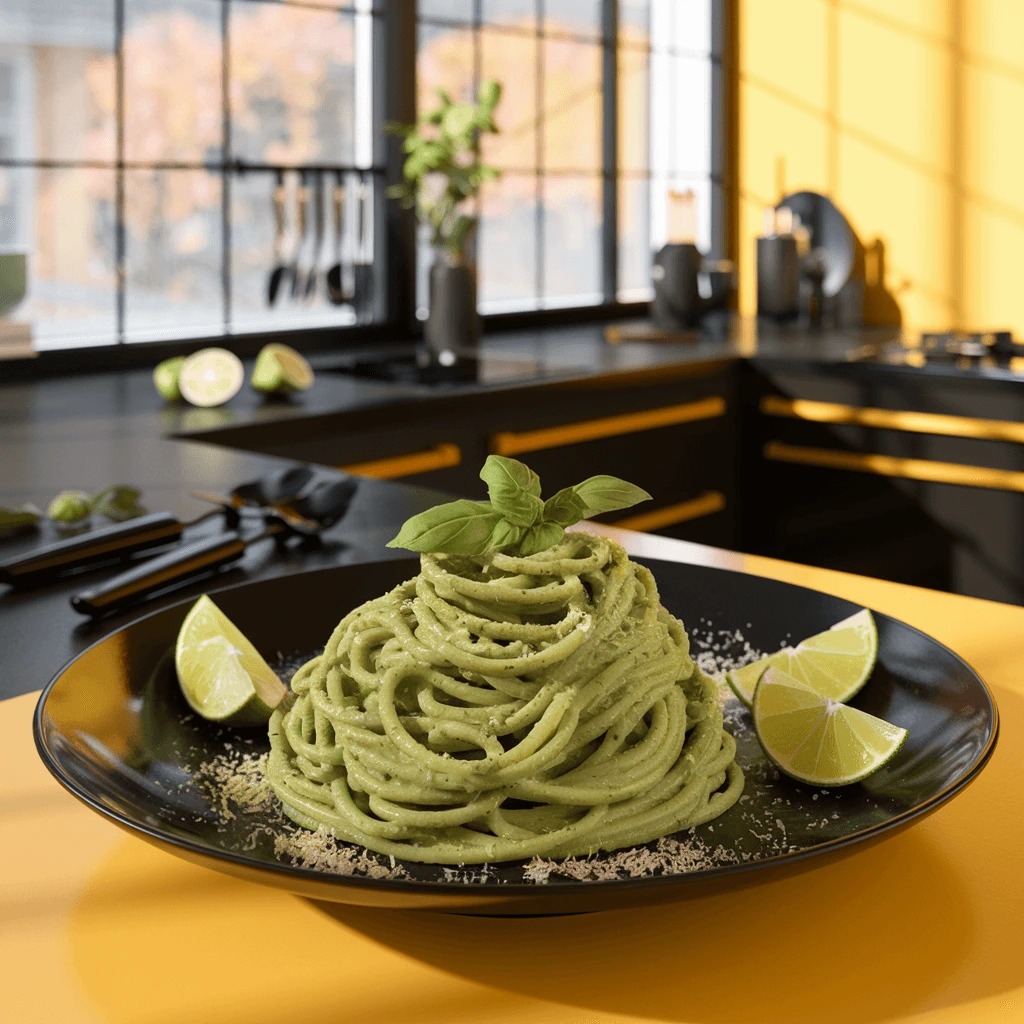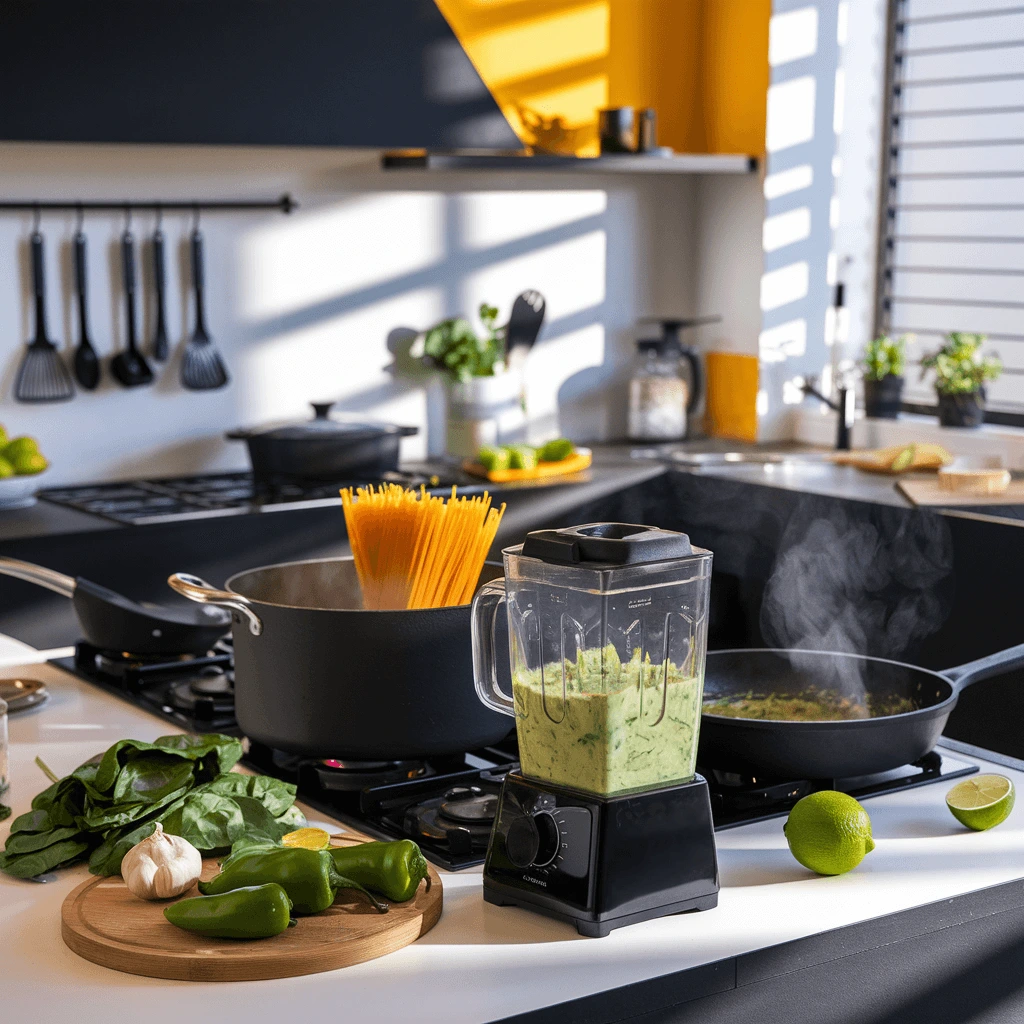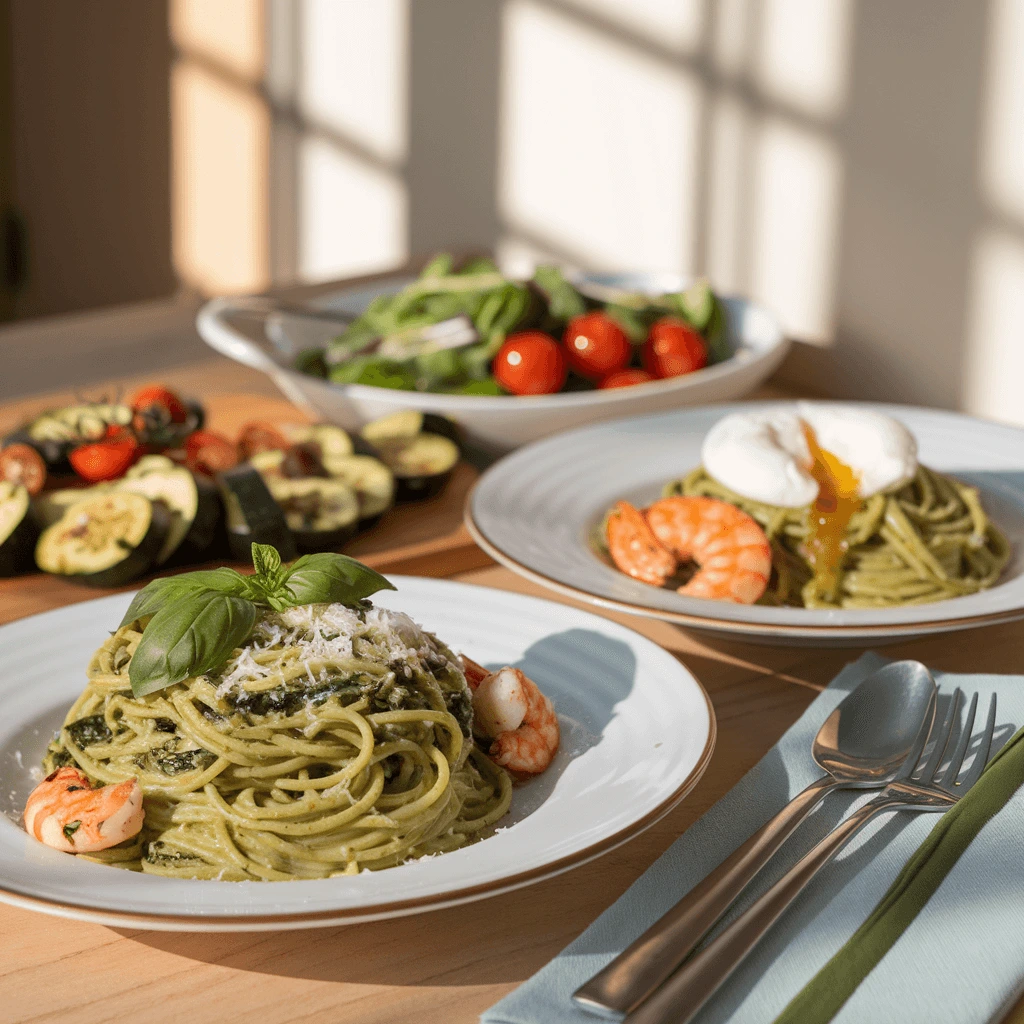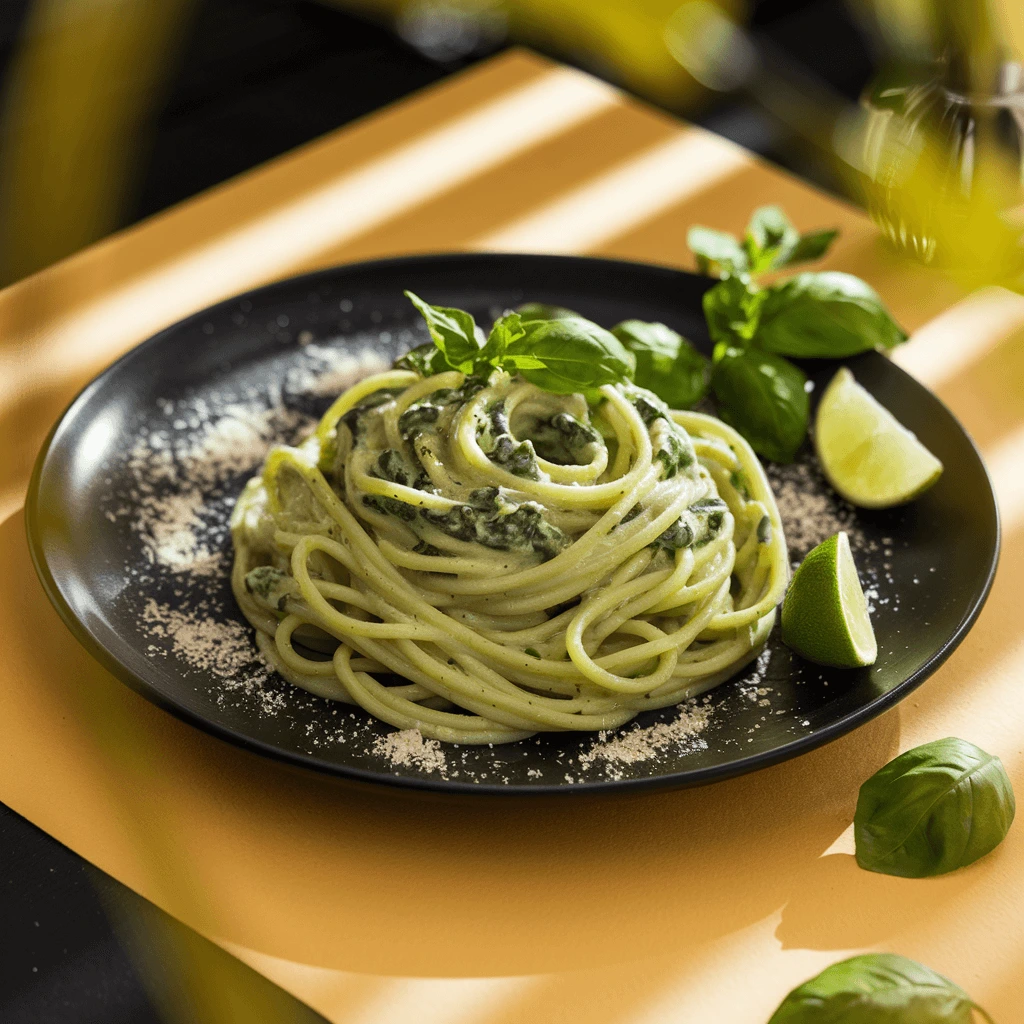Green spaghetti is a vibrant and flavorful dish that brings a fresh twist to traditional pasta recipes. Its signature green sauce, often made with ingredients like poblano peppers, spinach, or basil, gives it a creamy texture and a burst of rich, herbaceous flavor. Perfect for weeknight dinners or as a crowd-pleasing meal, this recipe is both quick to make and easy to customize. Whether you’re looking for a vegetarian option, a family-friendly meal, or simply a way to add some color to your table, green spaghetti is a dish you’ll love. After exploring the beloved classic flavors in our Mini Pancakes Recipe: Quick, Easy, and Delicious, let’s dive into this simple yet delicious recipe that’s sure to become a favorite in your kitchen!
Table of Contents
What is Green Spaghetti?
Green spaghetti is a delightful pasta dish celebrated for its vibrant green color and creamy, flavorful sauce. It stands out as a unique twist on traditional pasta dishes, blending rich, herbaceous flavors with the comforting appeal of a classic spaghetti recipe. Its green hue is typically achieved by incorporating fresh or cooked green ingredients such as poblano peppers, spinach, basil, or even avocados. This dish is popular in Mexican cuisine, where it is often made with poblano peppers, creating a mildly spicy and smoky flavor profile.

What Makes Green Spaghetti Unique?
Unlike regular spaghetti dishes that rely on tomato-based or creamy white sauces, green spaghetti takes a bold departure with its use of green vegetables and herbs. The sauce is not only visually stunning but also packed with nutrients, making it a healthier option compared to heavier alternatives. Whether you prefer a vegetarian version or one enriched with proteins like chicken or shrimp, green spaghetti is incredibly versatile and can be tailored to suit your preferences.
Key Ingredients in Green Spaghetti
The core ingredients of green spaghetti include a mix of fresh and flavorful greens. Poblano peppers are often roasted and blended to create a creamy, mildly spicy base, while spinach or basil adds a fresh, earthy taste. To enhance the creaminess, ingredients like heavy cream, cream cheese, or sour cream are commonly used. For added depth, garlic, onions, and a touch of lime or lemon juice might be incorporated. And of course, the star of the dish is perfectly cooked spaghetti, which serves as the base for this delicious sauce.
Variations of Green Spaghetti
Green spaghetti is incredibly adaptable, offering endless possibilities for customization. You can make it vegetarian by sticking to greens and dairy-based ingredients or take it up a notch by adding grilled chicken, shrimp, or even chorizo for a protein-packed meal. If you’re looking for a vegan option, you can substitute cream with coconut milk or cashew cream and skip any animal-based ingredients. Additionally, you can make it gluten-free by swapping traditional spaghetti for gluten-free pasta or zucchini noodles.
This unique dish has something for everyone, from its visually appealing presentation to its versatility in flavors and ingredients. Green spaghetti is not just a recipe; it’s a creative way to reinvent a pasta classic while keeping it fresh, flavorful, and exciting!
How to Make Green Spaghetti at Home
Making green spaghetti at home is a simple and rewarding process that combines fresh ingredients with straightforward techniques. With just a handful of steps, you can create a dish that’s not only visually stunning but also full of flavor. Whether you’re an experienced cook or new to the kitchen, this recipe is easy to follow and quick to prepare, making it perfect for busy weeknights or last-minute meals.
Step-by-Step Instructions
- Prepare the Pasta:
Begin by boiling a pot of water with a pinch of salt. Cook the spaghetti in boiling water until al dente, following the package instructions. Set aside about a cup of pasta water before draining to adjust the sauce’s consistency if needed. - Roast or Cook the Green Ingredients:
For the vibrant sauce, roast poblano peppers until their skins are charred, then peel and remove the seeds. Alternatively, sauté spinach, basil, or other green vegetables in a pan with a bit of olive oil until they soften. - Blend the Sauce:
In a blender, combine the roasted poblanos (or your chosen greens), garlic, onion, cream, and a touch of lime or lemon juice. Blend until smooth. For a thinner sauce, gradually add pasta water until you reach the desired consistency. - Cook the Sauce:
Pour the blended mixture into a large pan or skillet and simmer over low heat. Add seasonings such as salt, pepper, and a pinch of chili flakes if you prefer some heat. Stir occasionally to ensure the sauce thickens evenly. - Combine Pasta and Sauce:
Add the cooked spaghetti to the skillet and toss it with the sauce.
Toss gently to coat the pasta evenly, allowing the spaghetti to absorb the flavors. If the sauce feels too thick, add a bit more reserved pasta water to loosen it. - Serve and Garnish:
Transfer the green spaghetti to serving plates and garnish with your favorite toppings. Options include grated Parmesan cheese, chopped fresh herbs like parsley or cilantro, or even a sprinkle of toasted breadcrumbs for added texture.
Essential Kitchen Tools
To make green spaghetti at home, you’ll need a few basic tools:
- Blender or Food Processor: To blend the green sauce into a smooth, creamy texture.
- Large Pot: For boiling the spaghetti.
- Skillet or Saucepan: To simmer and combine the sauce with the pasta.
- Tongs or Pasta Spoon: For tossing the spaghetti with the sauce.
Tips for Perfect Green Spaghetti
- Roast for More Flavor: Roasting poblano peppers or garlic can enhance the depth of flavor in the sauce.
- Use Fresh Ingredients: Opt for fresh spinach, basil, or any other greens to maximize flavor and color.
- Customize the Spice Level: Adjust the amount of chili or peppers based on your heat tolerance.
- Balance the Acidity: A squeeze of lime or lemon juice can brighten the sauce and balance the creaminess.
- Don’t Overcook the Pasta: Cooking the spaghetti to al dente ensures it holds up well when mixed with the sauce.
By following these simple steps and tips, you’ll have a delicious and creamy green spaghetti dish ready to impress your family or guests in no time!

Delicious Ways to Serve Green Spaghetti
Green spaghetti is a versatile dish that can be served in various ways to suit different occasions, dietary preferences, and flavor profiles. Whether you’re keeping it simple or looking to elevate it with exciting accompaniments, this vibrant pasta dish is the perfect canvas for your culinary creativity.
1. As a Standalone Dish
Green spaghetti is flavorful and hearty enough to shine on its own, making it an excellent choice for a satisfying meal. The creamy green sauce made with ingredients like poblano peppers, spinach, or basil delivers a burst of freshness that pairs perfectly with tender spaghetti.
- Light Yet Filling Meal: Serve it as a standalone vegetarian option for a lighter dinner.
- Toppings for Extra Flavor: Add grated Parmesan cheese, a drizzle of olive oil, or a sprinkle of chili flakes to enhance the flavors.
- Perfect for Any Occasion: This version works wonderfully for casual weeknight dinners or as a simple but elegant meal for guests.
2. Paired with Proteins
Adding proteins to your green spaghetti can elevate it into a more robust and satisfying dish. Here are some protein options that complement the creamy, herbaceous flavors:
- Grilled Chicken or Shrimp: These are classic choices that balance the creaminess of the sauce with their light, savory flavors. Season them with garlic and herbs for a perfect pairing.
- Crispy Bacon or Chorizo: For a richer taste, crispy bacon bits or spicy chorizo can add depth and texture to the dish.
- Tofu or Tempeh: For a vegetarian or vegan option, marinated and pan-seared tofu or tempeh can provide a protein boost while keeping the dish plant-based.
- Poached or Fried Egg: A runny egg yolk mixed into the pasta can create an extra creamy texture and add an indulgent touch.
3. For Special Occasions
Green spaghetti can easily transition from a casual meal to a stunning dish for special occasions. Its vibrant color and creamy texture make it a conversation starter at any gathering.
- Plated Elegance: Serve individual portions garnished with fresh herbs, a sprinkle of Parmesan, and a drizzle of truffle oil for a sophisticated presentation.
- Family-Style Sharing: Present it in a large serving dish for family-style dining, paired with a side of crusty garlic bread or a fresh green salad.
- Holiday or Party Theme: Incorporate it into themed dinners or holiday spreads. Its bright green hue makes it a festive choice for St. Patrick’s Day or Christmas celebrations.
4. Side Dishes and Pairings
To round out the meal, consider pairing green spaghetti with complementary sides:
- Fresh Salads: A crisp salad with mixed greens, cucumbers, and a light vinaigrette complements the richness of the spaghetti.
- Garlic Bread or Breadsticks: These make excellent accompaniments for soaking up the creamy sauce.
- Roasted Vegetables: Add a tray of roasted vegetables like asparagus, zucchini, or cherry tomatoes for a balanced and colorful plate.
Green spaghetti is as versatile as it is delicious. Whether served as a simple dish, paired with proteins, or elevated for special occasions, it’s guaranteed to delight everyone at the table. Experiment with these serving suggestions to create the perfect meal that suits your taste and occasion!

Common Questions About Green Spaghetti
As with any dish that’s as unique as green spaghetti, you might have a few questions or concerns about how to make it, store it, or customize it to suit your preferences. Here, we address some of the most common questions about this vibrant and flavorful pasta dish to help you get the most out of your green spaghetti experience.
1. Can I Use Other Types of Pasta?
While traditional green spaghetti is made with classic spaghetti, one of the great things about this dish is its versatility when it comes to pasta choice. You can experiment with different types of pasta based on your preferences or dietary needs.
- Other Pasta Types: Green spaghetti pairs beautifully with other pasta shapes like linguine, fettuccine, or penne. Choose the type of pasta that best suits your texture preference or what you have on hand.
- Gluten-Free Pasta: For those following a gluten-free diet, there are plenty of gluten-free pasta options available, including those made from rice, corn, or quinoa. These varieties work wonderfully with the creamy green sauce, ensuring that everyone can enjoy this delicious dish.
- Zucchini Noodles (Zoodles): If you’re looking for a lighter, low-carb option, zucchini noodles are a fantastic alternative. You can spiralize zucchini to make “zoodles,” which will still absorb the sauce beautifully, providing a fresh and healthy twist.
2. How Long Does Green Spaghetti Last?
If you have leftovers after enjoying your green spaghetti, you’re in luck! Green spaghetti can be stored for later, but there are a few things to keep in mind when it comes to storage.
- Storing Leftovers: Green spaghetti can be stored in an airtight container in the refrigerator for up to 3–4 days. The creamy sauce will keep its flavor, though the pasta may slightly absorb some of the sauce over time.
- Reheating Tips: When reheating, it’s best to warm the spaghetti gently on the stovetop over low heat. Add a splash of reserved pasta water or a little extra cream to help loosen the sauce and bring back its creamy consistency. You can also reheat it in the microwave, stirring occasionally to ensure even heating.
- Freezing Green Spaghetti: While fresh green spaghetti is best enjoyed right away, it can be frozen for up to 1 month. To freeze, place the cooked pasta and sauce in a freezer-safe container. When ready to eat, thaw overnight in the fridge and reheat as needed, adding a little extra cream or pasta water to maintain the creamy texture.
3. What Can I Substitute for Poblano Peppers?
Poblano peppers are a common ingredient in green spaghetti, lending a mild heat and a smoky flavor to the dish. However, if you’re unable to find poblano peppers or simply prefer a different taste, there are several substitutions you can try:
- Bell Peppers: If you want to skip the heat entirely, bell peppers—especially green bell peppers—can serve as a great substitute. They provide a milder, sweeter flavor that still gives the sauce a green hue.
- Anaheim Peppers: Slightly milder than poblanos but still offering a touch of heat, Anaheim peppers can make a great replacement while maintaining the smoky undertones.
- Jalapeño Peppers: For those who like it spicy, jalapeños can be a perfect substitute, though you may want to adjust the quantity to control the heat level.
- Spinach or Kale: If you prefer a milder, green-based sauce without any peppers, spinach or kale can be pureed and used as the main green ingredient in the sauce, providing a slightly different but still vibrant flavor.
4. Can I Make Green Spaghetti Ahead of Time?
Yes! Green spaghetti can be partially made ahead of time to save you time during meal prep or on a busy evening.
- Sauce Preparation: You can make the green sauce ahead of time, store it in an airtight container, and refrigerate it for up to 2–3 days. When you’re ready to serve, simply reheat the sauce on the stove and toss it with freshly cooked pasta.
- Fully Assembled Dish: If you want to make the entire dish in advance, it’s best to store the pasta and sauce separately to prevent the pasta from absorbing too much sauce. When ready to serve, just combine them and reheat gently.
- Meal Prep: Green spaghetti also works well for meal prepping. Portion out individual servings into containers and store in the refrigerator for up to 4 days. For a quick meal, simply reheat the portions and enjoy!
5. How Can I Make Green Spaghetti Vegan?
If you’re looking for a vegan version of green spaghetti, there are easy substitutions to make it plant-based while retaining the creamy, flavorful qualities of the original dish:
- Vegan Cream or Coconut Milk: Substitute the heavy cream or sour cream with coconut milk, cashew cream, or any plant-based cream alternative. These will help achieve the creamy texture without the dairy.
- Nutritional Yeast: Instead of Parmesan cheese, sprinkle nutritional yeast on top for a cheesy, umami flavor that’s completely dairy-free.
- Tofu or Tempeh for Protein: For a protein boost in your vegan green spaghetti, try adding marinated and sautéed tofu or tempeh. They can absorb the flavors of the sauce while providing a satisfying texture.
These common questions about green spaghetti can help you navigate different variations, make it in advance, and store or customize it to suit your needs. Whether you’re making it gluten-free, vegan, or looking for ways to change up the flavor, green spaghetti is an incredibly adaptable dish that fits many different tastes and lifestyles!
For more great pasta recipes, check out the book Pasta Grannies on Amazon.
